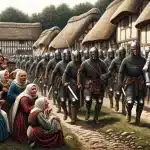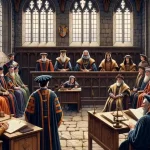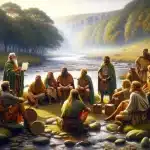Last Updated on 22/05/2025 by Alex Hamlyn
Table of Contents
The figure of the witch has haunted the British imagination for centuries, evolving from powerful mythological beings and respected healers to targets of widespread panic and persecution, and eventually, to a symbol of misunderstood spirituality. As part of the series on witchcraft in Britain, this article will highlight some of the individuals named as witches, real and suspected, through British history. From ancient Celtic whispers to 20th-century courtrooms, we will explore their backgrounds, the accusations they faced, their ultimate fates, and their echoes in time and culture.
The concept of individuals wielding supernatural power stretches back into British pre-history, where evidence of ritualistic practices and apotropaic symbols (charms to ward off evil) suggests a complex relationship with the unseen world. While not “witches” in the later, demonised sense, figures in Celtic mythology, such as the formidable Morrigan, a goddess associated with fate, war, and transformation, or Cerridwen, a keeper of the cauldron of knowledge and inspiration, and Brigid, linked to healing, poetry, and smithcraft, embody aspects of magical power and wisdom that would be later twisted into accusations of malevolent witchcraft. These deities were an integral part of the spiritual landscape, revered rather than feared. Archaeological finds, like the mummified cat discovered in Pendle, believed to be a protective charm, hint at folk magic practices designed to protect and heal, a far cry from the diabolical pacts alleged in later centuries.
The Pendle Witches
Perhaps the most notorious witch trial in English history, the case of the Pendle Witches unfolded in Lancashire in 1612. The accusations centered around two rival families headed by elderly, impoverished women: Elizabeth Southerns (known as “Old Demdike”) and Anne Whittle (“Old Chattox”). Both women were well-known local figures who engaged in folk magic, healing, and fortune-telling.
The initial accusation arose when Alizon Device, Demdike’s granddaughter, allegedly cursed a pedlar, John Law, after he refused to give her pins. Law subsequently suffered a stroke. This sparked a wider investigation led by local magistrate Roger Nowell. The accusations quickly escalated, involving claims of murder by witchcraft, making clay effigies, and attending a supposed witches’ Sabbat at Malkin Tower, Demdike’s home, on Good Friday. Many of the accused implicated each other, likely under pressure and in a climate of fear and suspicion. Key figures included Old Demdike, Old Chattox, Demdike’s daughter Elizabeth Device, and her children James and Jennet Device (whose testimony as a nine-year-old was crucial), and Alice Nutter, a woman of higher social standing.
Old Demdike died in prison before she could be tried. Ten others – Alizon Device, Elizabeth Device, James Device, Anne Whittle, Anne Redferne (Chattox’s daughter), Alice Nutter, Katherine Hewitt, Jane Bulcock, John Bulcock, and Isobel Robey – were found guilty and hanged in August 1612. One woman, Margaret Pearson, was sentenced to be pilloried. The trials were meticulously documented by the clerk of the court, Thomas Potts, in his book “The Wonderfull Discoverie of Witches in the Countie of Lancaster,” which amplified their fame.
Agnes Sampson and the North Berwick Witches
Across the border in Scotland, the North Berwick witch trials, beginning in 1590, were fueled by royal paranoia. King James VI of Scotland (later James I of England) developed a fervent belief in a widespread conspiracy of witches after his fleet was beset by storms while bringing his new bride, Anne of Denmark, to Scotland.

Agnes Sampson was a respected elderly woman from Humbie, known as a healer and midwife. She became a principal target in the North Berwick trials. Accusations included attending covens (notably at the Auld Kirk in North Berwick on Halloween), raising storms to sink the King’s ship, making wax images of the King to cause him harm, and communicating with the Devil. Other notable figures accused included Geillis Duncan, a servant girl whose “dancing” abilities were deemed suspicious, and Dr. John Fian, a schoolmaster.
Agnes Sampson initially denied the charges but confessed after enduring horrific torture, including the use of a “witch’s bridle” (an iron muzzle with prongs that entered the mouth) and sleep deprivation. She was interviewed by King James himself. Deemed guilty, Agnes Sampson was strangled and then her body was burned at the stake in January 1591. Many others implicated in the North Berwick trials met similar fates. King James VI’s obsession with witchcraft, further expounded in his 1597 book “Daemonologie,” significantly fanned the flames of witch-hunting throughout Britain. The themes of witchcraft, prophecy, and royal paranoia in Shakespeare’s Macbeth, particularly the “Weird Sisters,” are widely believed to have been influenced by the North Berwick trials and James’s known interests.
Eleanor Cobham, Duchess of Gloucester
Even the highest echelons of society were not immune to accusations of witchcraft, particularly when political motivations were at play. Eleanor Cobham was the wife of Humphrey, Duke of Gloucester, uncle to the young King Henry VI.
In 1441, Eleanor was accused of necromancy, heresy, and treason. The specific charges included consulting astrologers and a reputed witch, Margery Jourdemayne (the “Witch of Eye”), to divine the future, specifically whether King Henry VI would die and if her husband would become king. It was alleged she had procured a wax image of the King and was slowly melting it to cause his death. Her ambition and her husband’s political rivalry with Cardinal Beaufort likely fueled the accusations.
Margery Jourdemayne was burned at the stake at Smithfield. Two of Eleanor’s other associates, Roger Bolingbroke (an astronomer) and Thomas Southwell (a canon), were also condemned; Bolingbroke was hanged, drawn, and quartered, while Southwell died in the Tower of London. Eleanor Cobham herself, though escaping execution, was forced to perform public penance, walking barefoot through London on three separate days, and was then sentenced to life imprisonment. She died in captivity in 1452. Shakespeare later dramatised her downfall in Henry VI, Part 2.
Bessie Dunlop
Bessie Dunlop, from Dalry in Ayrshire, Scotland, was tried in 1576. Her case is notable for its detailed account of interactions with the fairy world, a common element in Scottish folk belief that became intertwined with witchcraft accusations.
Dunlop was a farmer’s wife and healer. She claimed to have received her knowledge of healing and locating lost goods from a spirit named Thom Reid, who she said had died at the Battle of Pinkie Cleugh in 1547. Thom, according to Bessie, acted as an intermediary with the “gude wichtis” (good wights or fairies) of the “Court of Elfame” (Faerie). She was accused of sorcery and witchcraft, primarily due to these claimed supernatural communications, which were seen as diabolical by the authorities. She insisted her powers were used for good, to cure people and animals.
Despite her claims of benevolent magic and her refusal to renounce her Christian faith when allegedly pressed by the fairies, Bessie Dunlop was found guilty of witchcraft. She was strangled and burned at the stake in November 1576.
Isabel Gowdie
Isabel Gowdie’s case from Auldearn, Nairnshire, Scotland, in 1662 is remarkable for the extraordinarily detailed and vivid voluntary confessions she gave over several weeks, apparently without the use of severe torture (though sleep deprivation and pricking were likely employed).

A young housewife, Gowdie’s confessions provided some of the most elaborate accounts of witchcraft beliefs in Britain. She claimed to have made a pact with the Devil, renounced her baptism, and attended Sabbats. She described shapeshifting into animals like cats and hares (famously stating “I shall go into a hare, With sorrow and sych and meickle care; And I shall go in the Devil’s name, Ay while I come home again”), flying on enchanted horses, and using charms and effigies to harm her neighbours. She also spoke of encounters with the Queen of Elfame.
The exact fate of Isabel Gowdie is unknown as the records are incomplete. However, given the nature of her confessions and the practices of the time, execution by strangulation and burning would have been the typical sentence. Her detailed testimonies have heavily influenced folkloric and literary depictions of witchcraft.
The Bideford Witches
The trial of Temperance Lloyd, Mary Trembles, and Susanna Edwards in Bideford, Devon, in 1682 holds the grim distinction of being among the last executions for witchcraft in England. (Alice Molland was condemned in Exeter in 1685, though evidence of her execution is less definitive).
Temperance Lloyd was an elderly, impoverished woman who had been accused of witchcraft previously. The fresh accusations arose when a local man, Thomas Eastchurch, attributed his lingering illness to Lloyd’s malevolence. Mary Trembles and Susanna Edwards were subsequently implicated, accused of causing sickness and tormenting individuals through witchcraft. The evidence was largely based on hearsay, spectral evidence (victims claiming to be tormented by the accused’s spirit), and the discovery of “witch’s marks” on their bodies.
All three women confessed, likely under duress and intense leading questions. They were tried at the Exeter Assizes, found guilty, and hanged on August 25, 1682. Their case highlights the persistence of witch beliefs even as intellectual skepticism was beginning to grow.
Gwen ferch Ellis
In Wales, witch trials were less common than in England or Scotland, but they did occur. Gwen ferch Ellis of Llandyrnog, Denbighshire, is recorded as the first woman to be executed for witchcraft in Wales under the Elizabethan Witchcraft Act of 1563.
Tried in 1594, Gwen was a healer who used charms. An accusation arose when a charm, written backwards (which was interpreted as a curse rather than a healing spell), was found in the home of a local gentleman with whom she seemingly had some association or dispute via another party. She was subsequently accused by several people of causing illness and even death through witchcraft.
Gwen ferch Ellis was found guilty and hanged in Denbigh town square in 1594.
Mother Shipton (Ursula Southeil)
Mother Shipton is one of England’s most famous prophetesses, often anachronistically labelled a witch, though she was more of a seer. Born Ursula Southeil around 1488 in Knaresborough, Yorkshire, her life is shrouded in legend.
Reputedly born in a cave, she was described as unusually ugly from birth. She married Tobias Shipton and gained a reputation for her prophecies. While she lived in an era when witchcraft accusations were starting to build, she was primarily known for her foretellings, which were published posthumously and often embellished. These included predictions of the Great Fire of London, the defeat of the Spanish Armada, and even much later inventions. She was seen as a “cunning woman” with foresight.
Mother Shipton died naturally around 1561. While stories portray her as witch-like, she was not formally tried or persecuted for witchcraft during her lifetime, though her image became increasingly associated with it in folklore.
James Murrell (“Cunning Murrell”)
Moving into a later period, James Murrell (c. 1785-1860) of Hadleigh, Essex, represents the “cunning man” or white witch. These individuals were often respected, if sometimes feared, members of their communities who used folk magic for healing, finding lost items, and counteracting perceived evil witchcraft.
Murrell was the seventh son of a seventh son, a traditional sign of psychic ability. He was a shoemaker by trade but gained fame as a diviner and astrologer. He possessed books of magic and was consulted by people from all walks of life for help with illnesses, bewitchment, and recovering stolen goods. He was said to use charms, herbs, and rituals.
Murrell was a well-known figure and died in 1860. While he operated within the realm of magic, as a “cunning man” offering services, he largely avoided the persecution faced by those accused of malevolent witchcraft in earlier centuries. His existence shows the persistence of magical beliefs and practices well into the 19th century.
Helen Duncan
The case of Helen Duncan brings the story of witchcraft accusations into the 20th century and marks the last person to be imprisoned under the Witchcraft Act of 1735.
Helen Duncan (1897-1956) was a Scottish spiritualist medium who gained notoriety for her physical mediumship, particularly the production of “ectoplasm.” During World War II, in November 1941, she purportedly revealed during a séance in Portsmouth that the battleship HMS Barham had been sunk, a fact not yet publicly released. This raised concerns within the Admiralty that she could reveal sensitive information, such as D-Day landing plans.
In January 1944, one of Duncan’s séances was raided by police. She was arrested and, controversially, prosecuted under the Witchcraft Act of 1735, ostensibly for fraudulently claiming to conjure spirits. Many believed the real motive was to silence her due to national security concerns. She was found guilty in April 1944 and imprisoned for nine months. Her case led to the repeal of the Witchcraft Act in 1951, replaced by the Fraudulent Mediums Act. Helen Duncan died in 1956, shortly after another police raid on a séance.
Conclusion
The stories of Britain’s accused witches paint a complex picture of social anxieties, religious fervour, misogyny, and the persecution of those who were different or who practised folk traditions. From the mythical figures of ancient lore to the cunning folk of villages, and from the politically charged accusations against the elite to the mass hysteria of the witch trials, the perception of the “witch” has continually shifted.
While the era of widespread persecution has passed, the figures of these real and suspected witches remain potent reminders of a dark chapter in British history, their tales continuing to fascinate and caution us about the dangers of fear, intolerance, ignorance, and the prices paid by real people when judgement is both swift and reckless.
Read more in this series
Witchcraft in Britain
An Introduction
Witches in Roman Britain
(1st-5th century)
Viking Britain and Witchcraft
(8th-11th century)
Medieval Britain and Witchcraft
(5th century onward)
Plantagenet and High Medieval Britain (12th-15th century)
17th Century: The Peak of Witch Hunts in Britain
Modern Britain And Witchcraft – As Strange As Ever
Witchcraft and the Celts
(Pre – AD43)
Witches in Saxon Britain
(5th-11th century)
Norman Britain and Witchcraft
(11th-12th century)
Early Modern Period and Restoration (15th-18th century)
Victorian Britain and Witchcraft
(19th-20th century)
Famous Witches in British History
(Plus one Witch Hunter)



